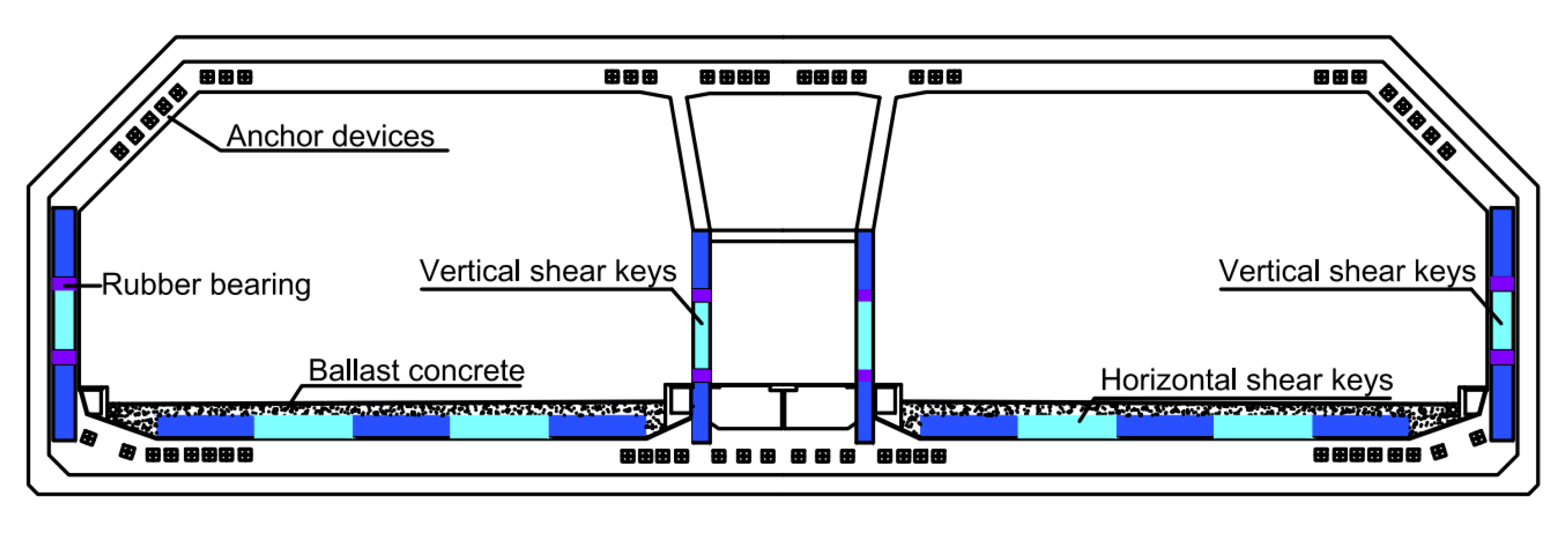Seismic Behavior of Shear Keys Enhanced with Novel Energy Absorption Devices in Immersion Joints Based on Pseudo-Static Tests
Abstract
:1. Introduction
2. Development of a Novel Arc-Shaped Energy Absorption Device
3. Pseudo-Static Tests on Seismic Performance of Shear Keys Reinforced by the Arc-Shaped Energy Absorption Devices
3.1. Details of the Testing Model
3.2. Test Setup and Sensors Arrangement
3.3. Loading Scheme
4. Testing Results and Analysis
4.1. Failure Mode
- (1)
- Similar to the actual immersed tunnel project, the gaps between the shear key and its neighboring major structure portions were filled by the rubber blankets in the tests. Deformation firstly occurred at the rubber blankets with retrospect to cyclic horizontal loading. Then, the deformation of the rubber blankets increased with the increase in load. Finally, oblique shear failure was observed at the central position of the rubber blankets arranged at the gaps between shear keys (Figure 9a);
- (2)
- Since a certain deformation occurred in the rubber blankets, the arc-shaped energy absorption devices got involved quickly (which also can be verified by Figure 10). The arc-shaped energy absorption devices had undergone the local buckling first, and then the failure of the core metal plate emerged (Figure 9b);
- (3)
- After the large-scale deformation occurred in both the rubber blankets and the arc-shaped energy absorption devices, the horizontal shear resistance of the model was mainly provided by the shear key. Concrete cracks with inclination angles in the range of 45–65° with respect to horizontal direction had been marked in the shear keys. Simultaneously, some cracks were also observed on the left and right sides of the bottom “U”-shaped portion (Figure 9c).
4.2. Load-Displacement Hysteretic Curves
4.3. Skeleton Curves
4.4. Stiffness Degradation
4.5. Shock Absorption Ability
4.6. Ductility
4.7. Discussion
5. Conclusions
- (1)
- Under the horizontal cyclic displacement loading, the horizontal forces were mainly from a synergistic effect of the rubber blankets, arc-shaped energy absorption devices, and shear keys. The failure mode of the testing specimens indicated that the arc-shaped energy absorption devices failed earlier than the shear keys. As a consequence, the arc-shaped energy absorption devices applied to the shear keys can prevent the shear keys from premature failure.
- (2)
- The shear key enhanced by the arc-shaped energy absorption devices exhibited better anti-seismic performances than an ordinary shear key. Loops in the hysteretic curves of S1 and S2 were plumper than those from S0. Comparing the load-bearing capacity of the shear key model with and without energy absorption devices reinforcement, the differences in the cracking load, yield load, peak load, and failing load were 33.0%, 36.7%, 26.0%, and 23.6%, respectively. The equivalent viscous coefficient values observed from S0 were smaller than those of S1 and S2.
- (3)
- The testing results revealed that as the axial pressure increased from 300 kN to 400 kN, obvious differences were observed in the load-bearing capacity, accumulated energy dissipation value, and initial stiffness. The growth ratios of load-bearing capacities (cracking load, yield load, peak load, and failing load) between S1 and S2 were 9.0%, 0.4%, 7.4%, and 24.4%, respectively. The accumulated energy dissipation values of S1 and S2 were 236,032 kN.mm and 241,601 kN.mm respectively. As for the initial stiffness, a comparison between S1 and S2 exhibited an increased ratio in the negative direction of approximately 20.0%. While the axial pressure had little influence on the equivalent viscous coefficient value and ductility ratio of the reinforced shear keys (through a comparison of the equivalent viscous coefficient value of S1 and S2, it was found that the maximum error was 0.01).
- (4)
- Analytical data also proposed that the deformation capacity of the energy absorption device should meet the limit requirement of relative displacement of the joint recommended by the related standards, and the combined shear stiffness of the rubber blankets, shear keys, and energy absorption devices also should be noted during the anti-seismic design process of an immersion joint.
- (5)
- The arc-shaped energy absorption device can provide theoretical basis and scientific support for further development of a new type of anti-seismic immersion joint and facilitate the application of tunnel shock control technology in engineering practice. However, this study was primarily focused on the energy absorption device made from Q235 metal, so further studies on the parameter optimization of the arc-shaped energy absorption device and other energy-absorptive material used for anti-seismic design of immersion joints are required.
Author Contributions
Funding
Institutional Review Board Statement
Informed Consent Statement
Data Availability Statement
Conflicts of Interest
References
- Gursoy, A. Immersed steel tube tunnels: An American experience. Tunn. Undergr. Space Technol. 1995, 10, 439–453. [Google Scholar] [CrossRef]
- Hu, Z.-N.; Xie, Y.-L.; Wang, J. Challenges and strategies involved in designing and constructing a 6 km immersed tunnel: A case study of the Hong Kong–Zhuhai–Macao Bridge. Tunn. Undergr. Space Technol. 2015, 50, 171–177. [Google Scholar] [CrossRef]
- Su, Q.K.; Zhu, Y.L.; Chen, Y.; Fang, L.; Yan, Y.; Su, Z.X.; Hans, D.W.; Li, Y. Hong Kong Zhuhai Macao Bridge-Tunnel project immersed tunnel and artificial islands—From an Owners’ perspective. Tunn. Undergr. Space Technol. 2022, 121, 104308. [Google Scholar] [CrossRef]
- Song, E.; Li, P.; Lin, M.; Liu, X. The rationality of semi-rigid immersed tunnel element structure scheme and its first application in Hong Kong Zhuhai Macao bridge project. Tunn. Undergr. Space Technol. 2018, 82, 156–169. [Google Scholar] [CrossRef]
- Bergsma, J.; Bakker, K.; Hart, C. Immersed tunnel design in subarctic rivers. Tunn. Undergr. Space Technol. 2017, 67, 158–166. [Google Scholar] [CrossRef]
- Zhou, X.; Sun, X.; Jiao, Y.-Y.; Zeng, B.; Tan, F.; Li, T.; Wei, P. Development and application of a new ballast water system for immersed tunnel installation: A case study of the Yuliangzhou tunnel in Xiangyang, China. Tunn. Undergr. Space Technol. 2022, 119, 104261. [Google Scholar] [CrossRef]
- Wu, H.; Rheem, C.-K.; Chen, W.; Xu, S.; Wu, W. Experimental study on the tension of cables and motion of tunnel element for an immersed tunnel element under wind, current and wave. Int. J. Nav. Arch. Ocean Eng. 2021, 13, 889–901. [Google Scholar] [CrossRef]
- Guo, J.; Jiang, S.; Zhang, Z. Fire Thermal Stress and its Damage to Subsea Immersed Tunnel. Procedia Eng. 2016, 166, 296–306. [Google Scholar] [CrossRef]
- Xu, X.; Tong, L.; Liu, S.; Li, H. Evaluation model for immersed tunnel health state: A case study of Honggu Tunnel, Jiangxi Province, China. Tunn. Undergr. Space Technol. 2019, 90, 239–248. [Google Scholar] [CrossRef]
- Zhao, K.; Wang, Q.; Chen, W.; Zhuang, H.; Chen, G. Uplift of immersed tunnel in liquefiable seabed under wave and current propagation. Eng. Geol. 2020, 278, 105828. [Google Scholar] [CrossRef]
- Zhao, K.; Wang, Q.; Chen, Q.; Zhuang, H.; Chen, G. Simplified effective stress modeling of shear wave propagation in saturated granular soils. Geotech. Lett. 2021, 11, 1–9. [Google Scholar] [CrossRef]
- Zhao, K.; Wang, Q.; Zhuang, H.; Li, Z.; Chen, G. A fully coupled flow deformation model for seismic site response analyses of liquefiable marine sediments. Ocean Eng. 2022, 251, 111144. [Google Scholar] [CrossRef]
- Anastasopoulos, I.; Gerolymos, N.; Drosos, V.; Kourkoulis, R.; Georgarakos, T.; Gazetas, G. Nonlinear Response of Deep Immersed Tunnel to Strong Seismic Shaking. J. Geotech. Geoenvironmental Eng. 2007, 133, 1067–1090. [Google Scholar] [CrossRef]
- Zhang, S.; Yuan, Y.; Li, C.; Chen, H.; Chen, Z. Seismic responses of long segmental immersed tunnel under unfavorable loads combination. Transp. Geotech. 2021, 30, 100621. [Google Scholar] [CrossRef]
- Hamada, M.; Shiba, Y.; Ishida, O. Earthquake observation on two submerged tunnels at Tokyo Port. In Proceedings of the Soil Dynamics and Earthquake Engineering Conference, Southampton, UK, 13–15 July 1982; pp. 723–735. [Google Scholar]
- Yuan, Y.; Shen, Z.Y.; Yu, H.T. Multibody dynamics method for longitudinal seismic response analysis of immersed tunnels. Eng. Mech. 2015, 32, 76–83. (In Chinese) [Google Scholar] [CrossRef]
- Rui, X.; He, B.; Lu, Y.; Lu, W.; Wang, G. Discrete Time Transfer Matrix Method for Multibody System Dynamics. Multibody Syst. Dyn. 2005, 14, 317–344. [Google Scholar] [CrossRef]
- Ding, J.-H.; Jin, X.-L.; Guo, Y.-Z.; Li, G.-G. Numerical simulation for large-scale seismic response analysis of immersed tunnel. Eng. Struct. 2006, 28, 1367–1377. [Google Scholar] [CrossRef]
- Yu, H.T.; Yuan, Y.; Liu, H.Z.; Li, Z.X. Mechanical model and analytical solution of stiffness for joints of immersed-tube tunnel. Eng. Mech. 2014, 31, 145–150. [Google Scholar] [CrossRef]
- Yuan, Y.; Luo, J.; Yu, H. Experimental Study on Vertical Shear Behaviors of an Immersion Joint with Steel Shear Keys. Appl. Sci. 2019, 9, 5056. [Google Scholar] [CrossRef] [Green Version]
- Xiao, W.; Yu, H.; Yuan, Y.; Taerwe, L.; Xu, G. Compression-shear behavior of a scaled immersion joint with steel shear keys. Tunn. Undergr. Space Technol. 2017, 70, 76–88. [Google Scholar] [CrossRef]
- Yu, H.T.; Xiao, W.H.; Yuan, Y.; Su, Q.K.; Xu, G.P. Experiment on stiffness ratio of immersion joint to immersed tunnel element. China J. Highw. Transp. 2016, 29, 134–141. (In Chinese) [Google Scholar]
- Wang, Z.; Jiang, L.; Gao, Y. Shaking table test of seismic response of immersed tunnels under effect of water. Soil Dyn. Earthq. Eng. 2019, 116, 436–445. [Google Scholar] [CrossRef]
- Yu, H.; Yuan, Y.; Xu, G.; Su, Q.; Yan, X.; Li, C. Multi-point shaking table test for long tunnels subjected to non-uniform seismic loadings—Part II: Application to the HZM immersed tunnel. Soil Dyn. Earthq. Eng. 2018, 108, 187–195. [Google Scholar] [CrossRef]
- Chen, H.; Li, X.; Yan, W.; Chen, S.; Zhang, X. Shaking table test of immersed tunnel considering the geological condition. Eng. Geol. 2017, 227, 93–107. [Google Scholar] [CrossRef]
- Li, Z.-X.; Li, C.-H.; Yan, J.-B. Seismic behaviour of hybrid-fibre reinforced concrete shear keys in immersed tunnels. Tunn. Undergr. Space Technol. 2019, 88, 16–28. [Google Scholar] [CrossRef]
- Yu, H.T.; Xiao, W.H.; Yuan, Y.; Liu, H.Z.; Jiang, Z.Y. Design and Experimental Verification of Seismic Mitigation and Energy-dissipated Equipment for Immersion Tunnel Joint. China J. Highw. Transp. 2016, 29, 142–148. [Google Scholar]
- Hu, Z. Research on Action Mechanisms and Structural Properties of Segmental Joint Shear Keys on Immersed Tunnel. Ph.D. Thesis, Chang’an University, Xi’an, China, 2015. (In Chinese). [Google Scholar]
- Li, Z.X. Theory and Technique of Engineering Structure Experiments; Tianjin University Press: Tianjin, China, 2004. (In Chinese) [Google Scholar]
- Cheng, X.J.; Jing, L.P.; Cui, J.; Liang, H.A.; Xu, K.P. Experimental research on seismic performance and energy dissipation for shear keys in immersion joints. J. Southwest Jiaotong Univ. 2021. [Google Scholar] [CrossRef]
- Park, R. Evaluation of ductility of structures and structural assemblages from laboratory testing. Bull. N. Z. Soc. Earthq. Eng. 1989, 22, 155–166. [Google Scholar] [CrossRef]
- Ministry of Transport of the People’s Republic of China. Chinese Specifications for Seismic Design of Highway Bridges; China Communication Press: Beijing, China, 2019. (In Chinese) [Google Scholar]
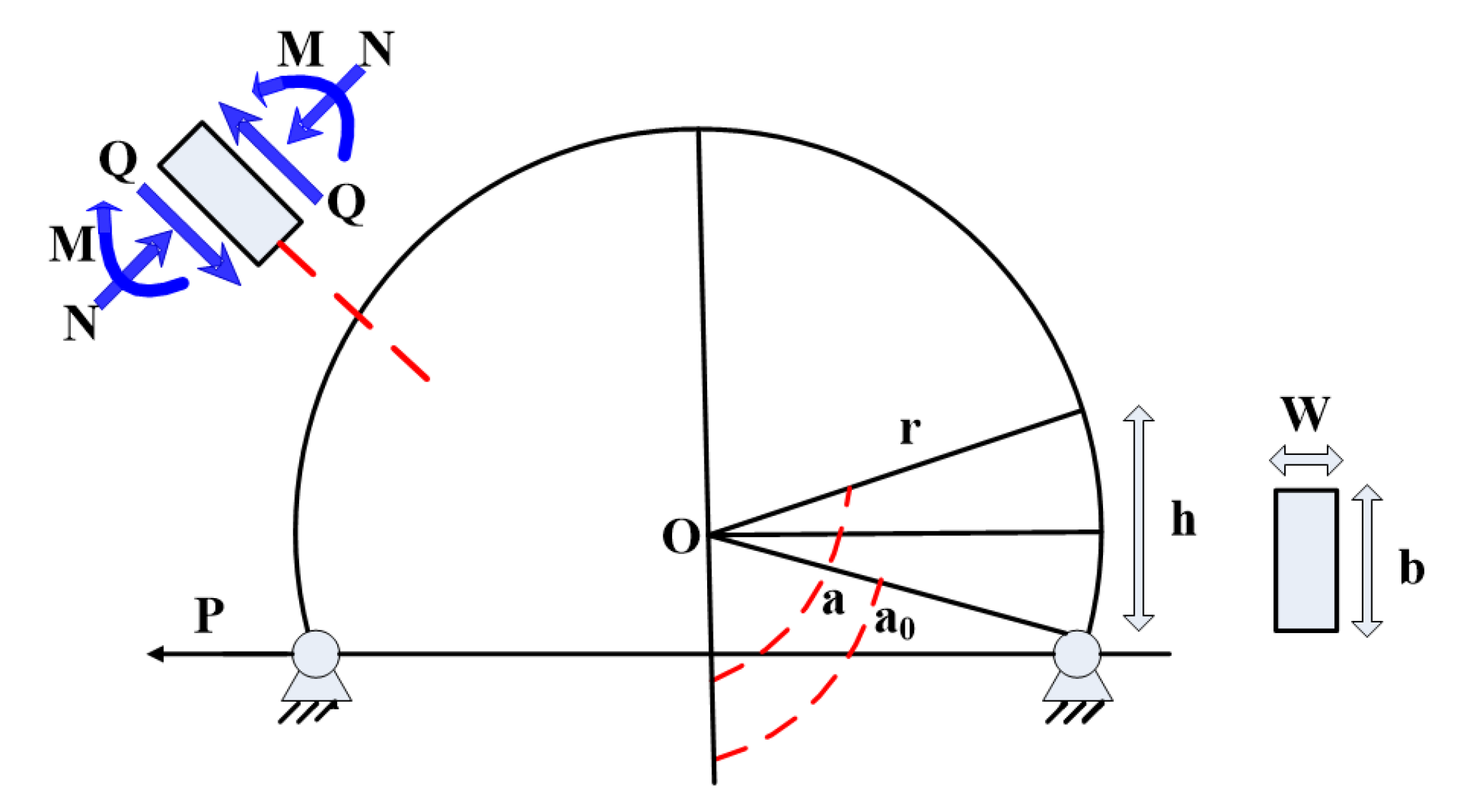

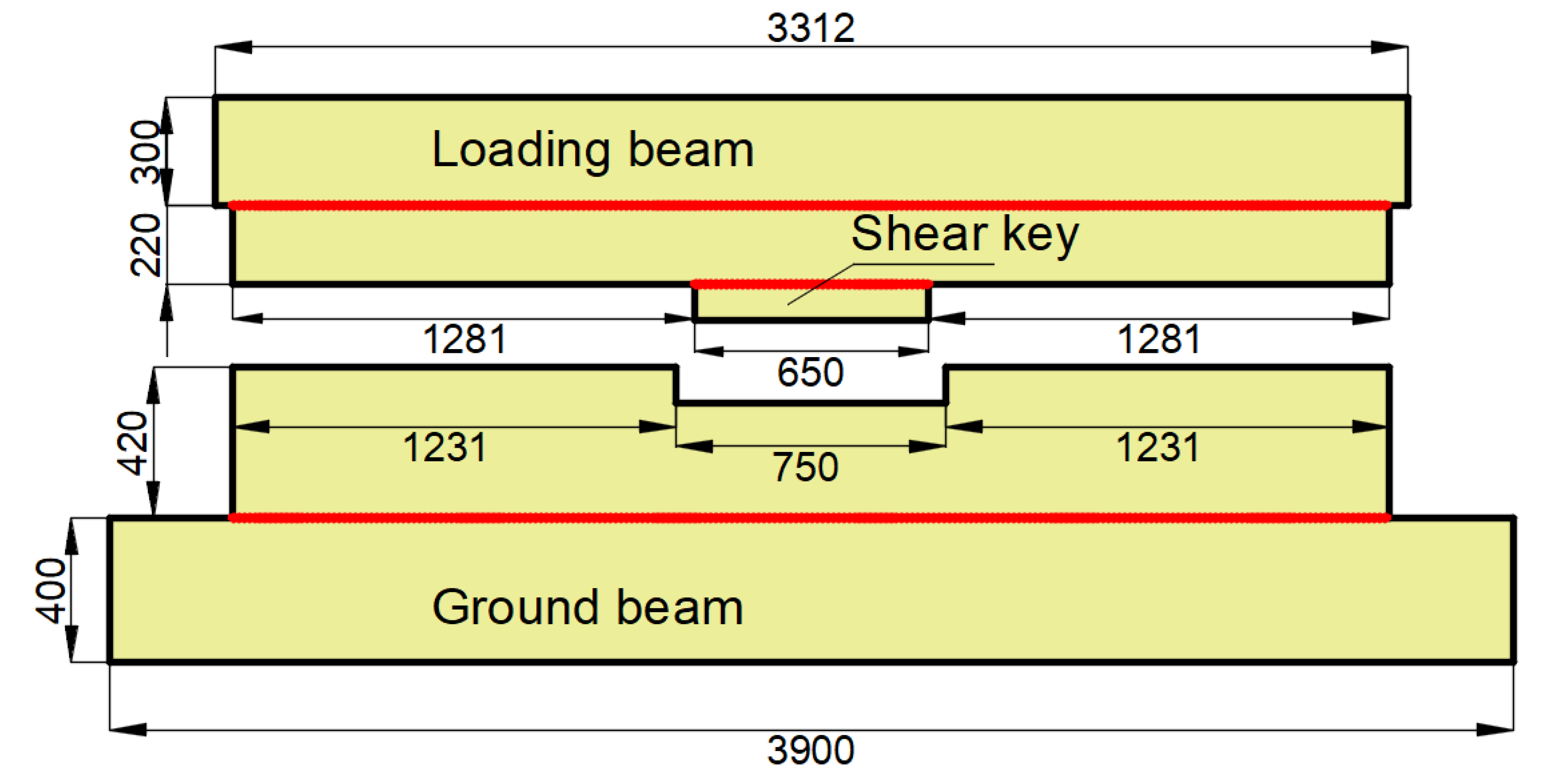

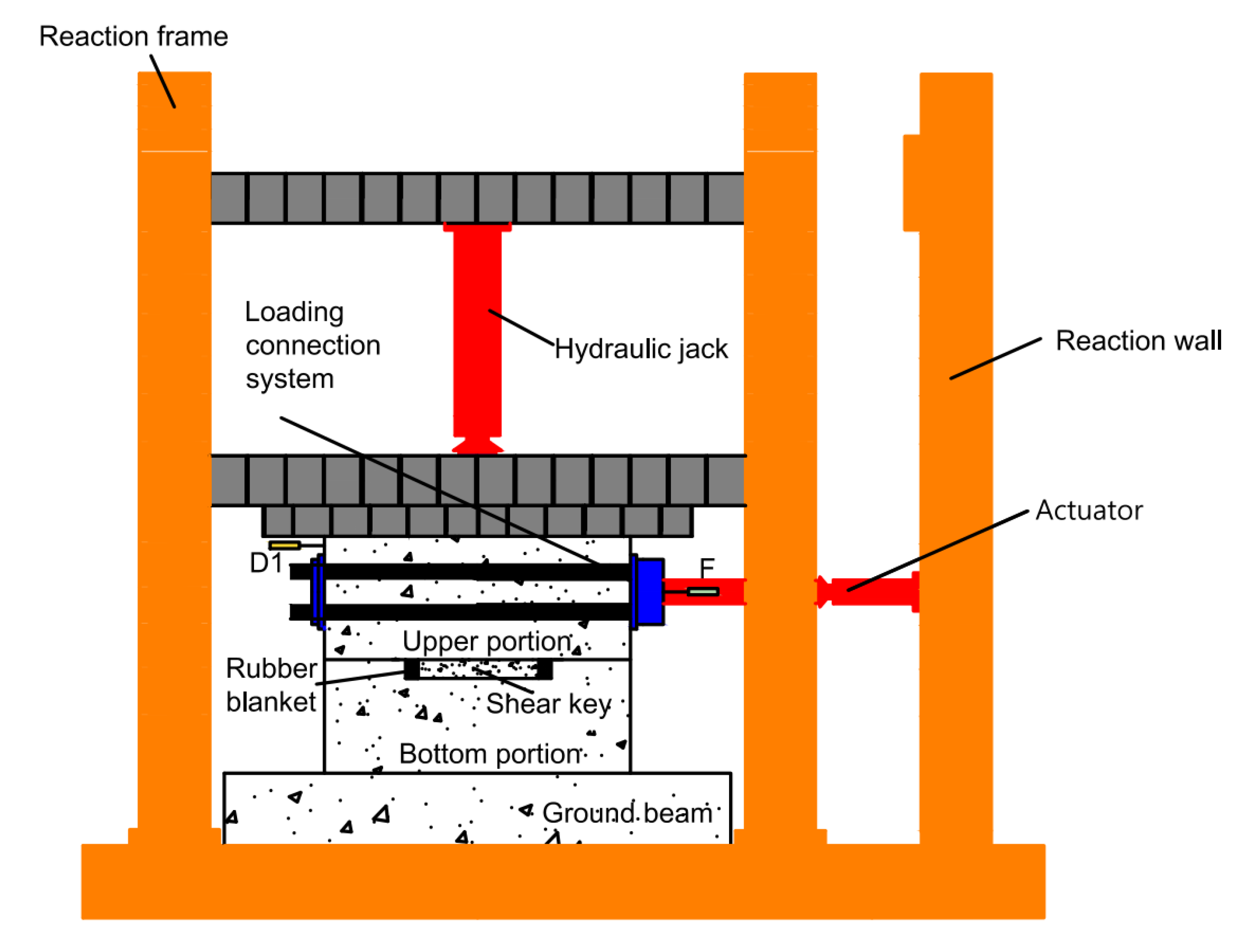

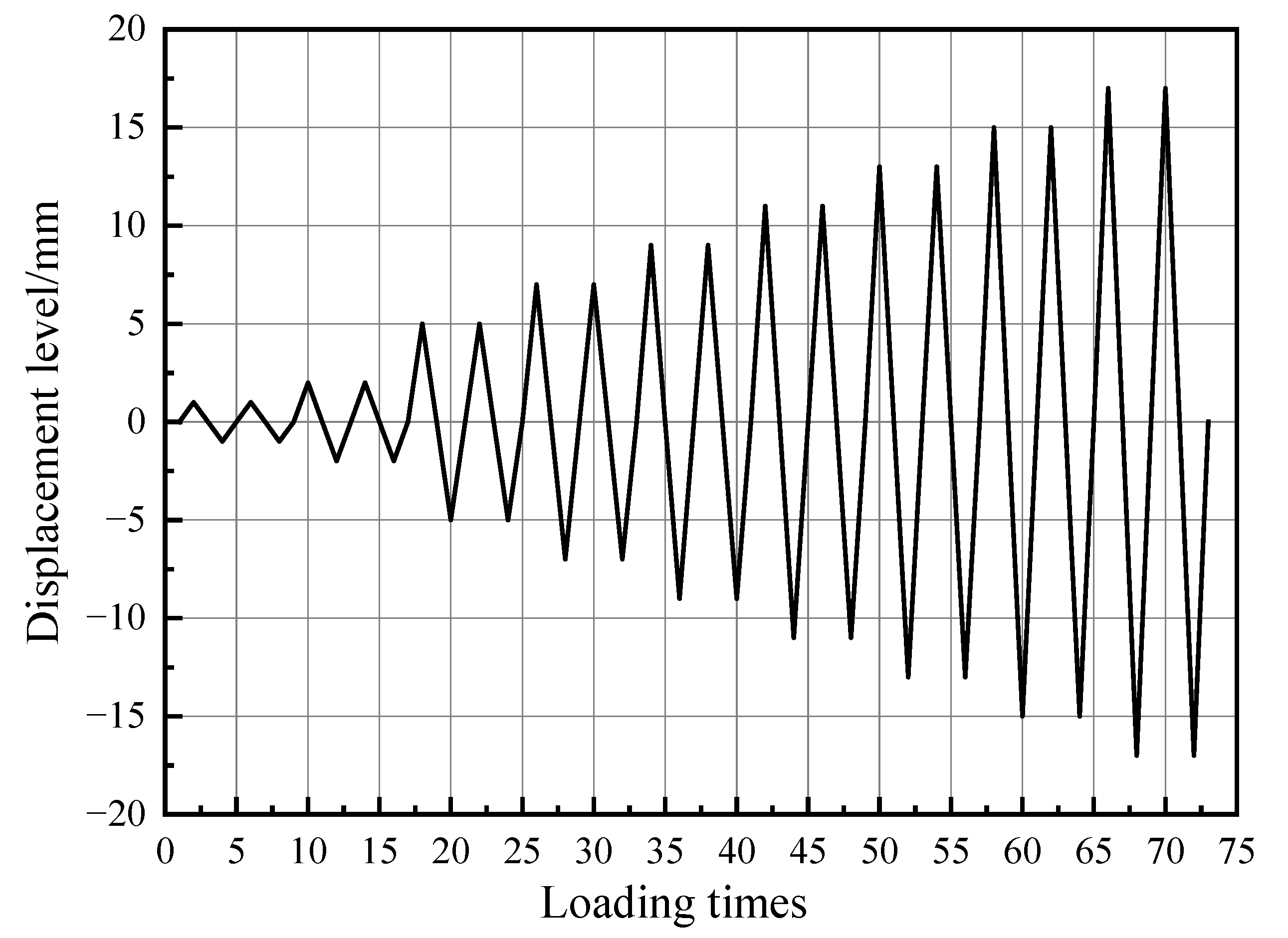
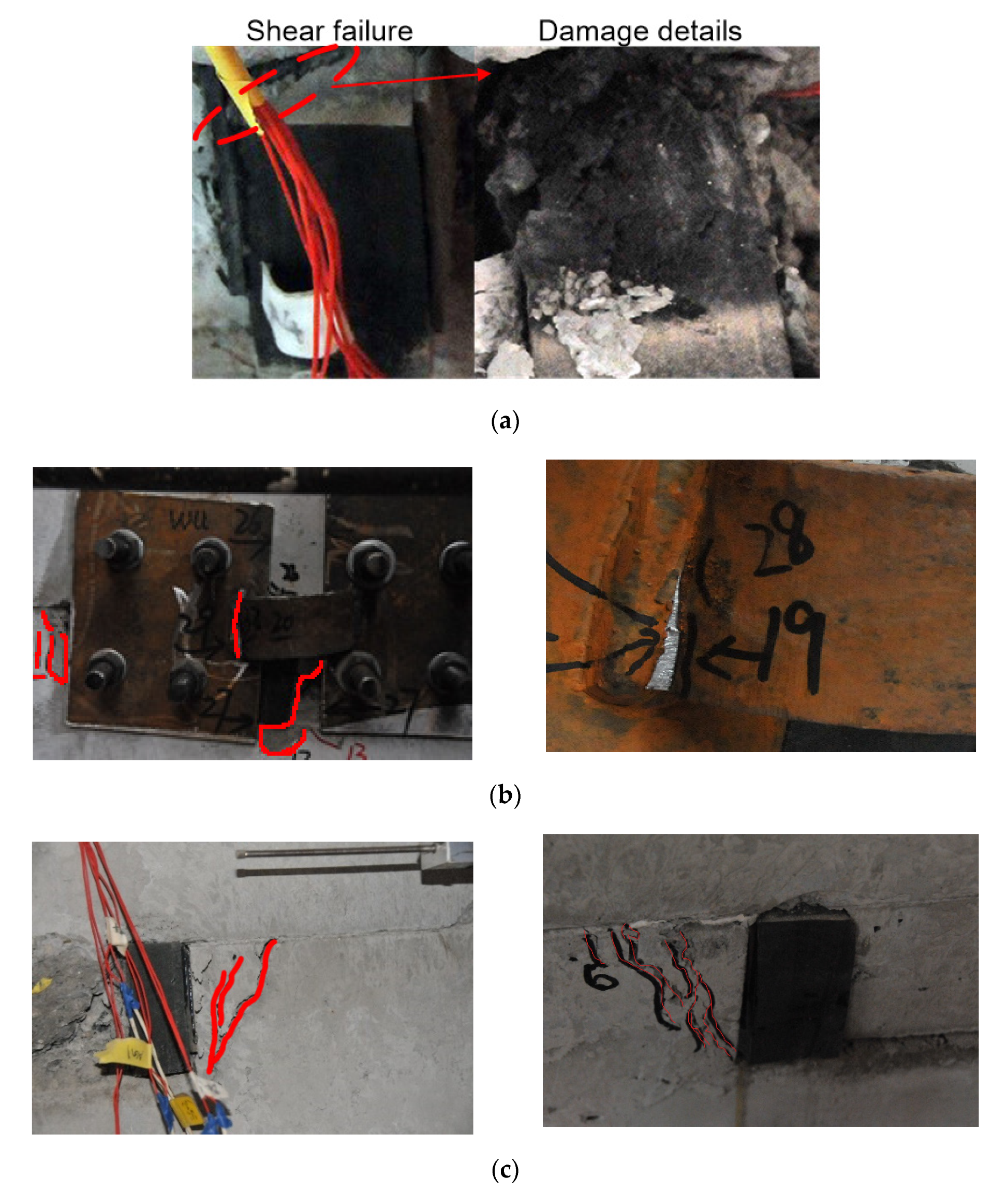

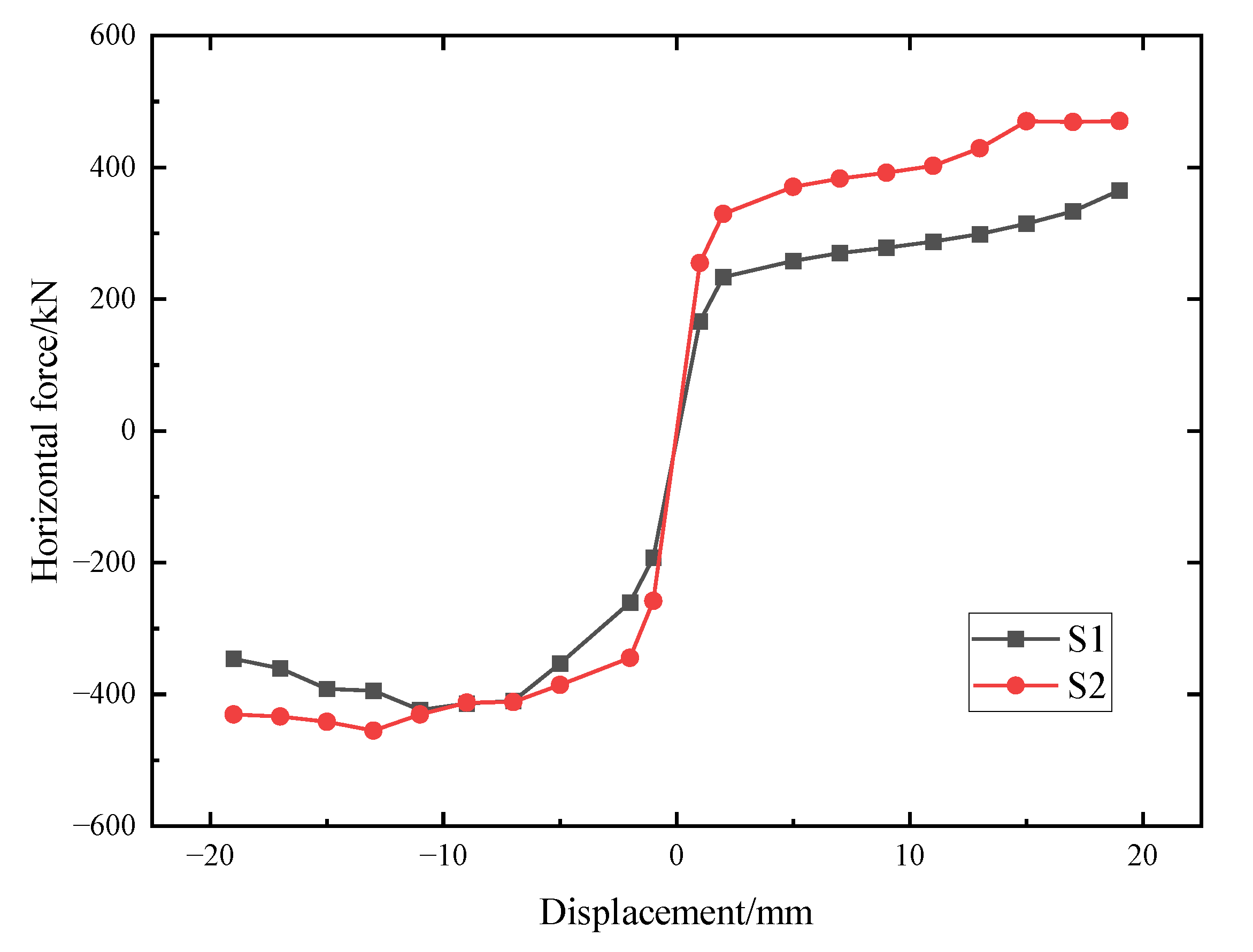
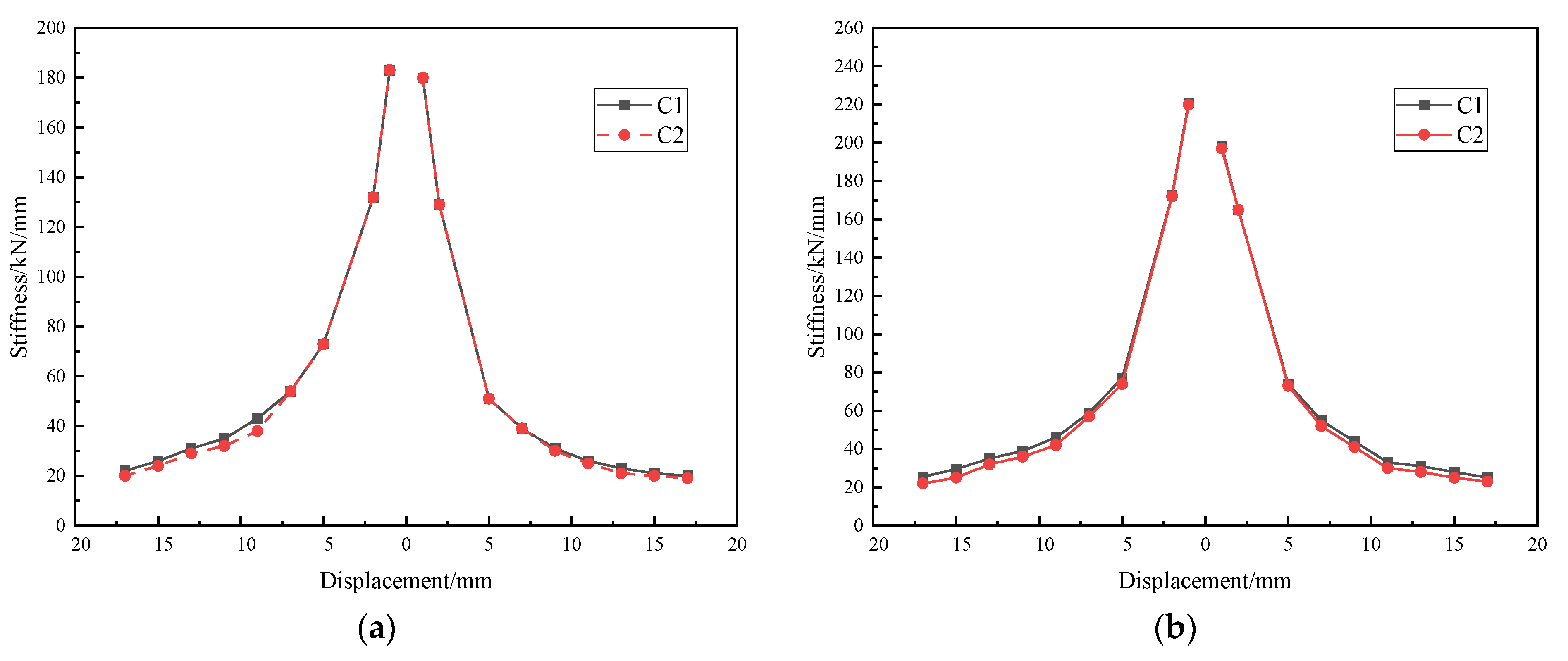
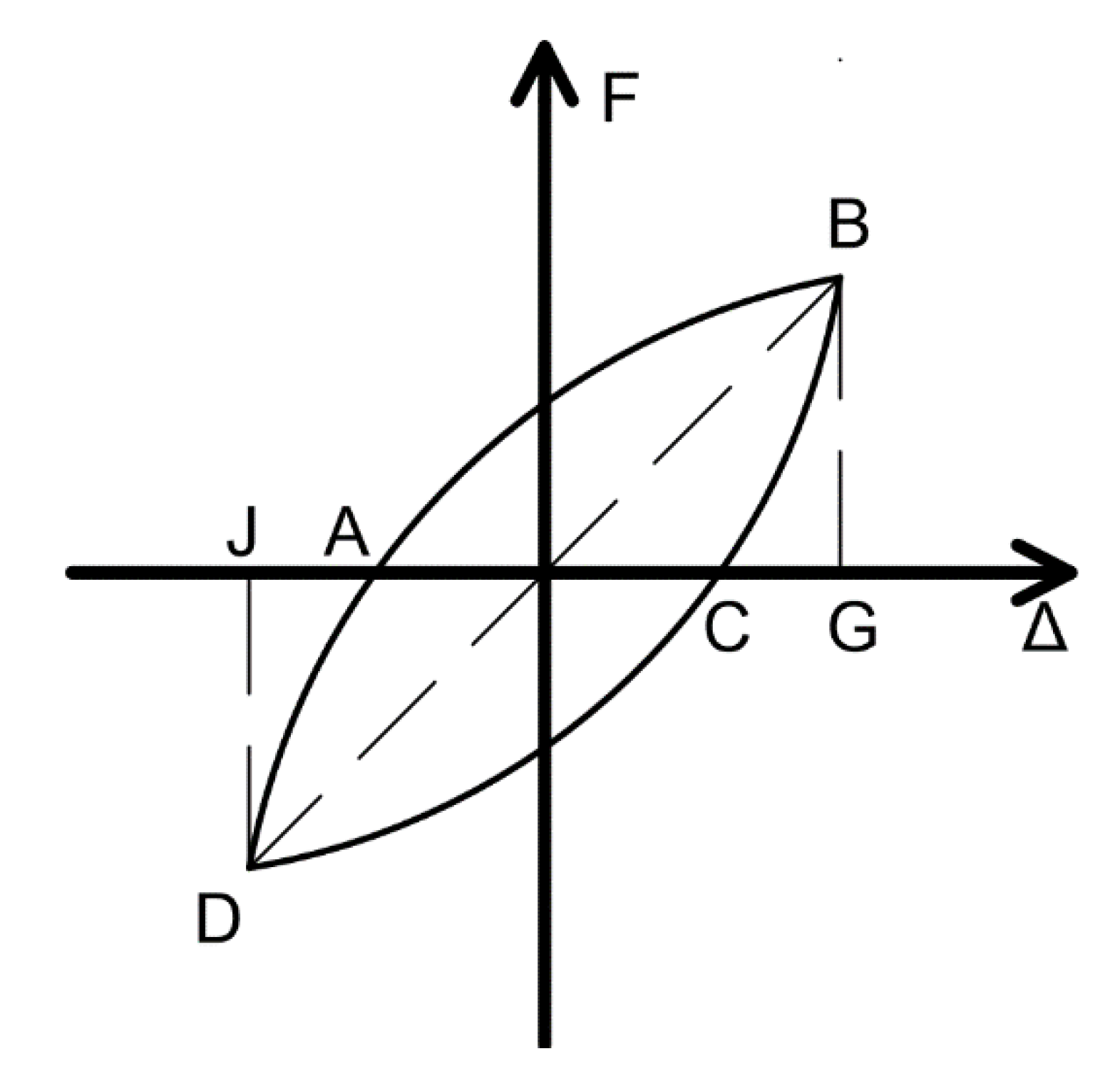

| Thickness/mm | Type | Yield Strength/MPa | Extension Stength/MPa | Elastic Modulus/GPa | Yielding to Tensile Strength Ratio |
|---|---|---|---|---|---|
| 10 | Q235 | 310 | 428 | 200 | 0.73 |
| Specimens | Concrete Mark | Steel Grade | Axial Pressure |
|---|---|---|---|
| S1 | C50 | HRB400 | 300 kN |
| S2 | C50 | HRB400 | 400 kN |
| Tests | β | |||
|---|---|---|---|---|
| Cracking Stage | Yield Stage | Deformation Development Stage | Failing Stage | |
| S0 | 0.32 | 0.31 | 0.28 | 0.26 |
| S1 | 0.37 | 0.36 | 0.32 | 0.28 |
| S2 | 0.38 | 0.36 | 0.33 | 0.29 |
Publisher’s Note: MDPI stays neutral with regard to jurisdictional claims in published maps and institutional affiliations. |
© 2022 by the authors. Licensee MDPI, Basel, Switzerland. This article is an open access article distributed under the terms and conditions of the Creative Commons Attribution (CC BY) license (https://creativecommons.org/licenses/by/4.0/).
Share and Cite
Cheng, X.; Xu, X.; Jing, L.; Liang, H.; Cui, J. Seismic Behavior of Shear Keys Enhanced with Novel Energy Absorption Devices in Immersion Joints Based on Pseudo-Static Tests. Materials 2022, 15, 4579. https://doi.org/10.3390/ma15134579
Cheng X, Xu X, Jing L, Liang H, Cui J. Seismic Behavior of Shear Keys Enhanced with Novel Energy Absorption Devices in Immersion Joints Based on Pseudo-Static Tests. Materials. 2022; 15(13):4579. https://doi.org/10.3390/ma15134579
Chicago/Turabian StyleCheng, Xinjun, Xiang Xu, Liping Jing, Haian Liang, and Jie Cui. 2022. "Seismic Behavior of Shear Keys Enhanced with Novel Energy Absorption Devices in Immersion Joints Based on Pseudo-Static Tests" Materials 15, no. 13: 4579. https://doi.org/10.3390/ma15134579
APA StyleCheng, X., Xu, X., Jing, L., Liang, H., & Cui, J. (2022). Seismic Behavior of Shear Keys Enhanced with Novel Energy Absorption Devices in Immersion Joints Based on Pseudo-Static Tests. Materials, 15(13), 4579. https://doi.org/10.3390/ma15134579





